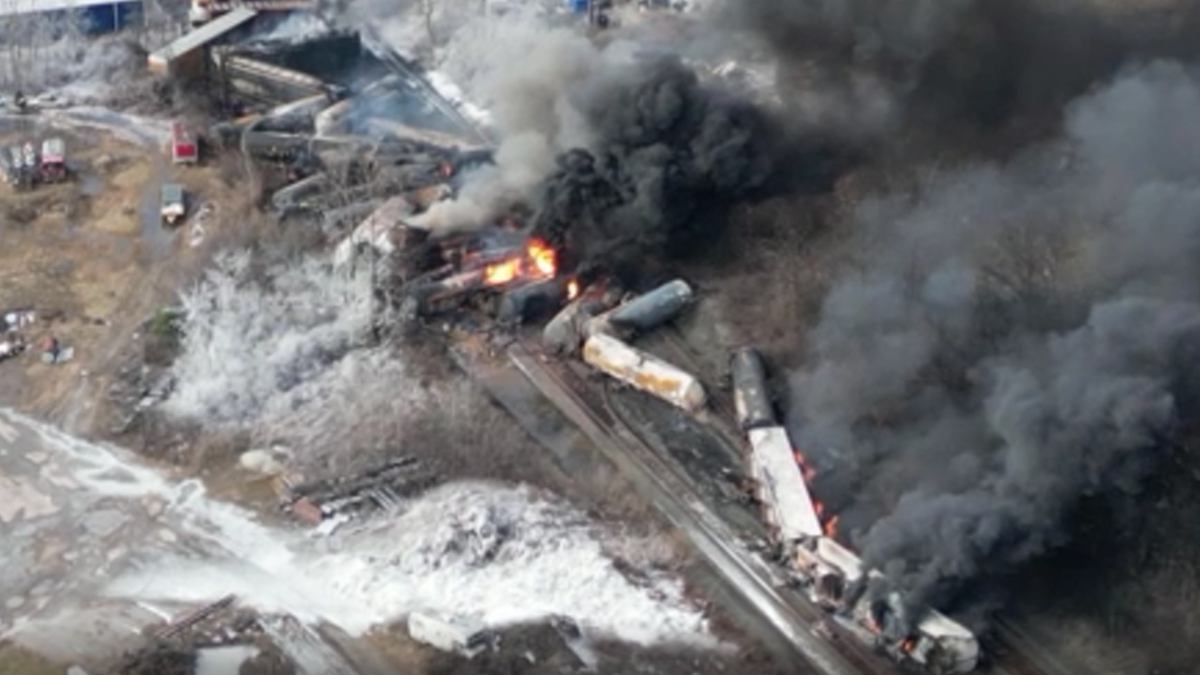Ohio Train Derailment: Lingering Toxic Chemicals In Buildings

Table of Contents
Pathways of Chemical Contamination in Buildings
The Ohio train derailment resulted in the release of various toxic chemicals, leading to multiple pathways of contamination impacting buildings in East Palestine. Understanding these pathways is crucial for effective remediation and mitigation of long-term health risks.
Airborne Contamination
Volatile organic compounds (VOCs), such as vinyl chloride, were released during the derailment and fire. These VOCs are readily airborne and can infiltrate buildings through various routes:
- Ventilation systems: Building HVAC systems can inadvertently draw in contaminated air, distributing VOCs throughout the interior.
- Cracks and gaps: Even minor gaps in windows, walls, or foundations can allow VOCs to seep into buildings.
- Open doors and windows: In the immediate aftermath of the derailment, open doors and windows could have facilitated significant VOC infiltration.
Long-term exposure to VOCs like vinyl chloride is linked to serious health problems, including:
- Respiratory issues (e.g., bronchitis, asthma)
- Liver damage
- Increased risk of various cancers
Detecting and removing airborne contaminants effectively presents a significant challenge due to the volatility and often invisible nature of these chemicals.
Surface Contamination
The derailment also resulted in the release of chemicals that could have settled on various surfaces within buildings. This surface contamination poses a direct contact hazard:
- Floors, walls, and furniture: Chemicals can adhere to these surfaces, especially porous materials like carpet and upholstery.
- Types of chemicals: Depending on the specific chemicals released and their properties, a range of contaminants might be present on surfaces, demanding specific cleaning protocols.
- Secondary contamination: Touching contaminated surfaces can lead to the transfer of chemicals to hands and clothing, causing further exposure.
Cleaning and decontaminating porous materials is particularly challenging, as chemicals can penetrate deep within the material, making complete removal difficult.
Groundwater Contamination
Chemical runoff from the derailment site could have infiltrated the soil and contaminated groundwater supplies. This poses a significant risk for buildings that rely on well water:
- Leaching into soil: Chemicals can leach from the soil into the groundwater, contaminating the water table.
- Impact on indoor plumbing: Buildings using contaminated well water could have contaminated plumbing systems, potentially exposing residents through direct contact with contaminated water.
- Health risks: Consuming or even showering with contaminated water can lead to a wide range of acute and long-term health problems.
The potential for long-term groundwater contamination requires thorough testing and potentially the implementation of alternative water sources for affected buildings.
Health Concerns Associated with Lingering Chemicals
Exposure to the toxic chemicals released during the Ohio train derailment poses significant health risks, both immediately and in the long term.
Acute Health Effects
Immediate exposure to high concentrations of certain chemicals can cause acute health effects, including:
- Respiratory irritation (coughing, shortness of breath)
- Headaches
- Nausea and vomiting
- Eye irritation
- Skin rashes
It's crucial for residents experiencing any of these symptoms to seek immediate medical attention. The CDC and other health agencies provide vital information and resources regarding chemical exposure and health.
Long-Term Health Risks
Even low-level, long-term exposure to certain chemicals can lead to severe health problems:
- Increased risk of various cancers (e.g., leukemia, lymphoma)
- Reproductive problems (e.g., infertility, birth defects)
- Neurological disorders (e.g., Parkinson's disease, Alzheimer's disease)
Many chemical-related diseases have a long latency period, meaning symptoms may not appear for years or even decades after exposure. Ongoing health monitoring for East Palestine residents is crucial to detect and address any potential long-term health consequences.
Testing and Remediation Efforts
Addressing the lingering threat of toxic chemicals in buildings requires comprehensive testing and remediation strategies.
Challenges in Testing for Contamination
Accurately testing for all potential contaminants in buildings presents numerous challenges:
- Specialized equipment: Identifying and quantifying specific chemicals requires sophisticated laboratory equipment and specialized expertise.
- Variability in chemical distribution: The concentration of chemicals can vary significantly within a building, requiring extensive sampling.
- Limitations of current testing methods: Current testing methodologies might not be able to detect all relevant chemicals or their metabolites.
Remediation Strategies
Various strategies are employed to decontaminate affected buildings:
- Air scrubbing: Using specialized equipment to filter and clean the air within buildings.
- Surface cleaning: Thorough cleaning and decontamination of surfaces using appropriate cleaning agents.
- Material removal: In cases of severe contamination, complete removal and disposal of affected materials (e.g., carpets, drywall) may be necessary.
The cost and complexity of remediation efforts can vary significantly depending on the extent of contamination and the building's construction. Proper disposal of contaminated materials is crucial to prevent further environmental pollution.
Conclusion
The Ohio train derailment in East Palestine has created a serious and ongoing threat to public health and the environment. Lingering toxic chemicals in buildings pose significant risks, from acute health problems to long-term illnesses. The challenges in testing and remediating contaminated buildings highlight the urgent need for comprehensive action. We must remain vigilant and demand ongoing monitoring, thorough testing, and effective remediation strategies to mitigate the long-term consequences of this disaster. Stay informed about ongoing developments, support affected communities, and contact local authorities or relevant health organizations for further information and assistance concerning the Ohio train derailment and building contamination. Together, we can work to ensure the safety and well-being of the East Palestine community and prevent similar tragedies in the future.

Featured Posts
-
 Prince Harry King Charles Silence Following Security Case
May 04, 2025
Prince Harry King Charles Silence Following Security Case
May 04, 2025 -
 Open Ais 2024 Developer Event Easier Voice Assistant Development
May 04, 2025
Open Ais 2024 Developer Event Easier Voice Assistant Development
May 04, 2025 -
 Ufc 314 Fight Card Main Event Prelims And Bout Order Announced
May 04, 2025
Ufc 314 Fight Card Main Event Prelims And Bout Order Announced
May 04, 2025 -
 The Blake Lively Anna Kendrick Feud A Detailed Timeline
May 04, 2025
The Blake Lively Anna Kendrick Feud A Detailed Timeline
May 04, 2025 -
 Capitals Announce All Caps 2025 Playoffs Initiatives A Vanda Pharmaceuticals Partnership
May 04, 2025
Capitals Announce All Caps 2025 Playoffs Initiatives A Vanda Pharmaceuticals Partnership
May 04, 2025
Latest Posts
-
 James Burns Belfast Hospital Hammer Incident Ex Soldiers Motivation Explored
May 04, 2025
James Burns Belfast Hospital Hammer Incident Ex Soldiers Motivation Explored
May 04, 2025 -
 Emma Stones Custom Louis Vuitton Sequin Dress At The 2025 Oscars
May 04, 2025
Emma Stones Custom Louis Vuitton Sequin Dress At The 2025 Oscars
May 04, 2025 -
 Oscars 2025 Fashion Emma Stones Show Stopping Sequin Gown And Old Hollywood Hair
May 04, 2025
Oscars 2025 Fashion Emma Stones Show Stopping Sequin Gown And Old Hollywood Hair
May 04, 2025 -
 Belfast Man Threatens Hospital With Hammer Ex Soldiers Violent Act
May 04, 2025
Belfast Man Threatens Hospital With Hammer Ex Soldiers Violent Act
May 04, 2025 -
 Emma Stones Oscars 2025 Look A Bold Sequin Louis Vuitton Dress And Classic Hairstyle
May 04, 2025
Emma Stones Oscars 2025 Look A Bold Sequin Louis Vuitton Dress And Classic Hairstyle
May 04, 2025
